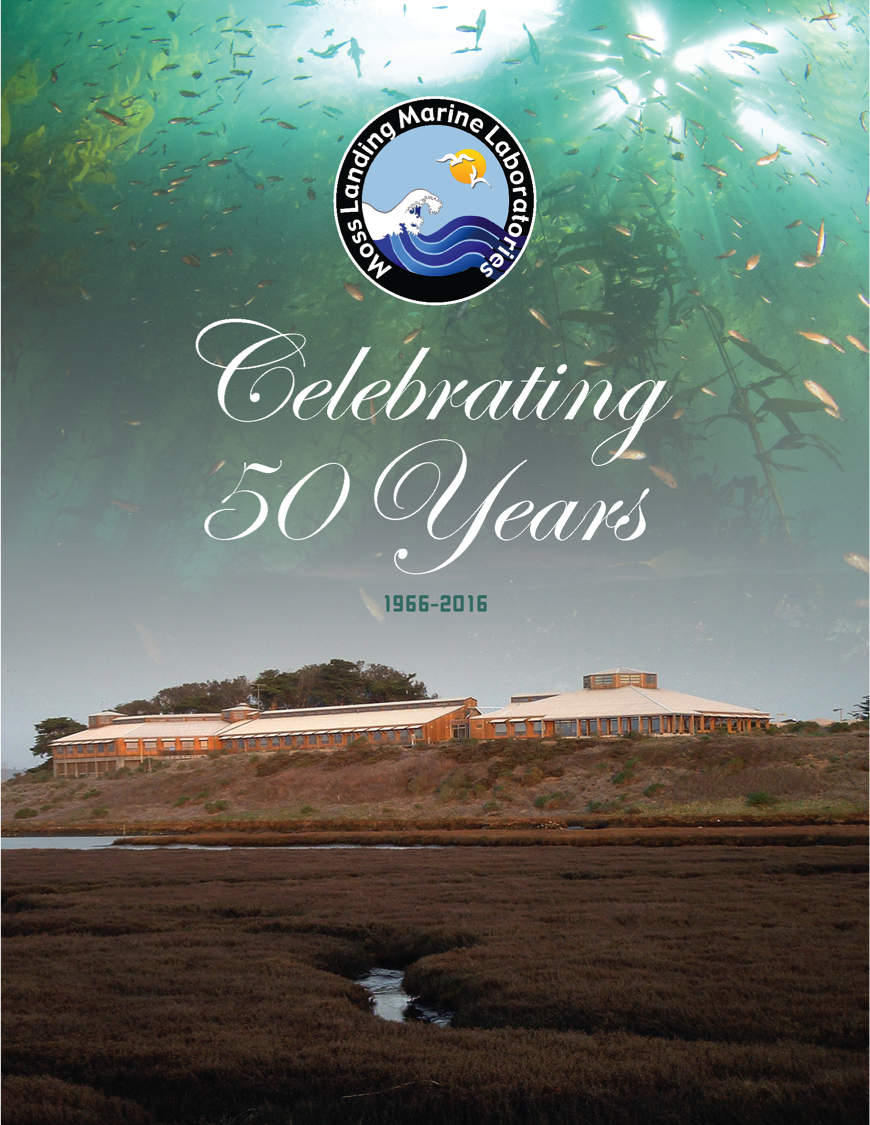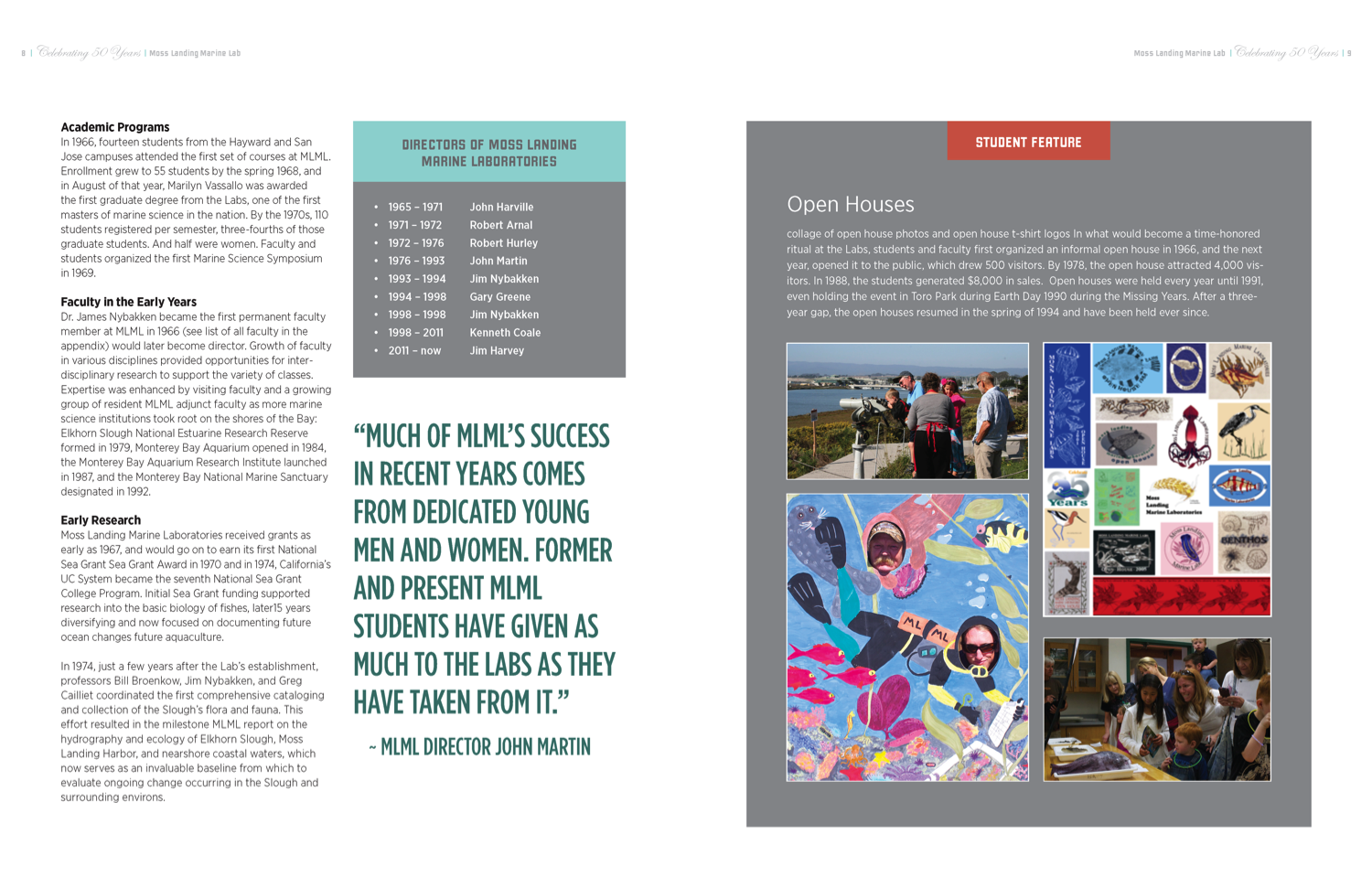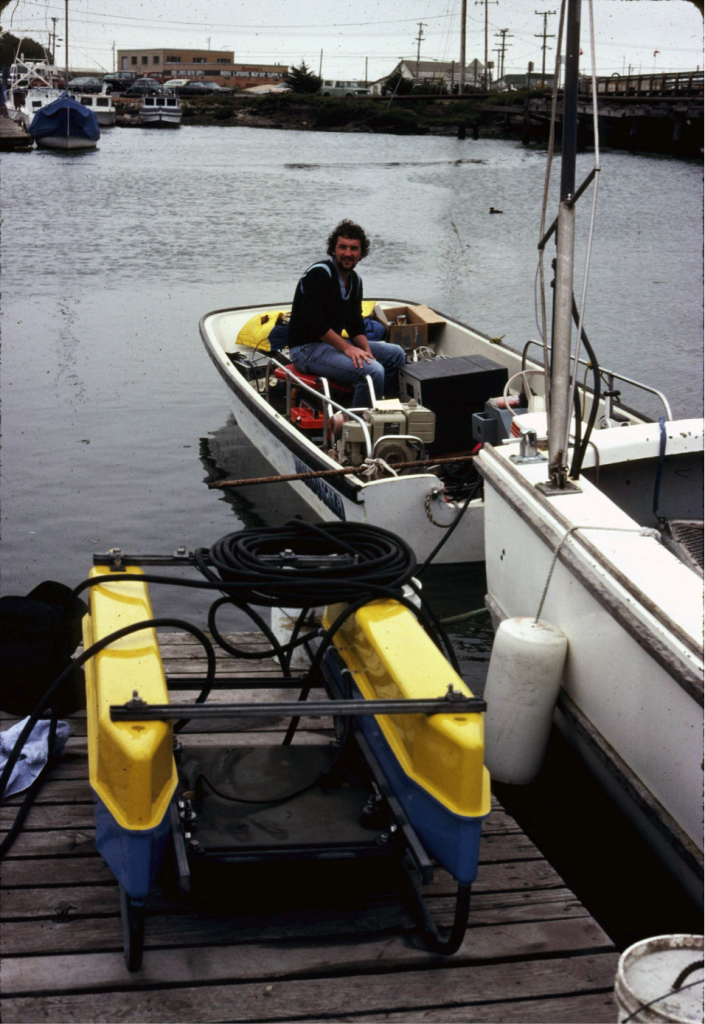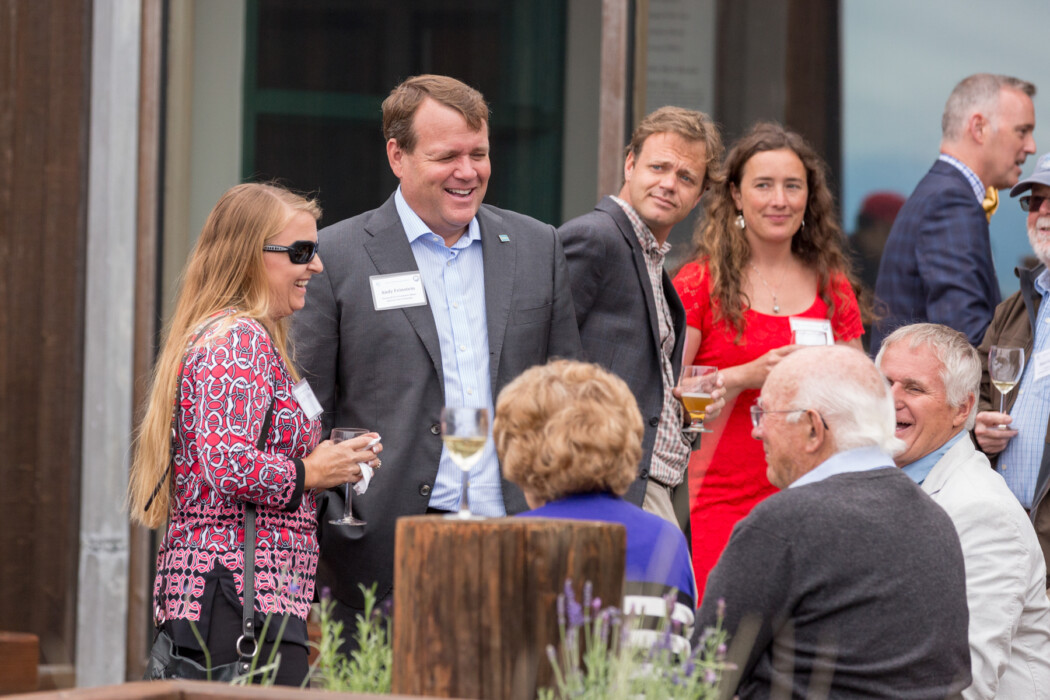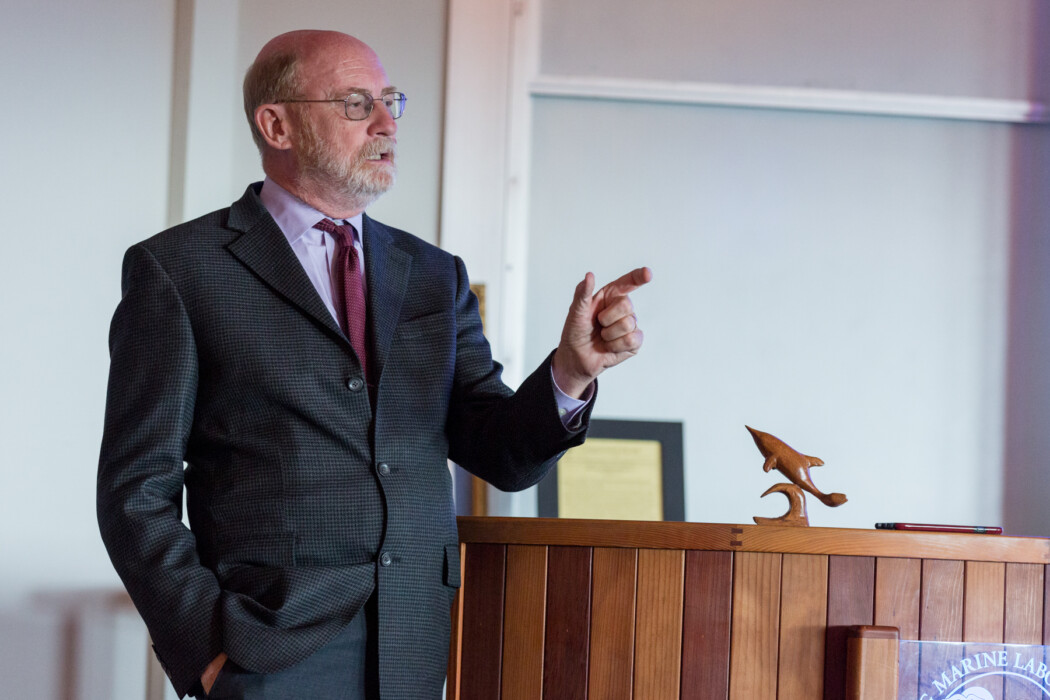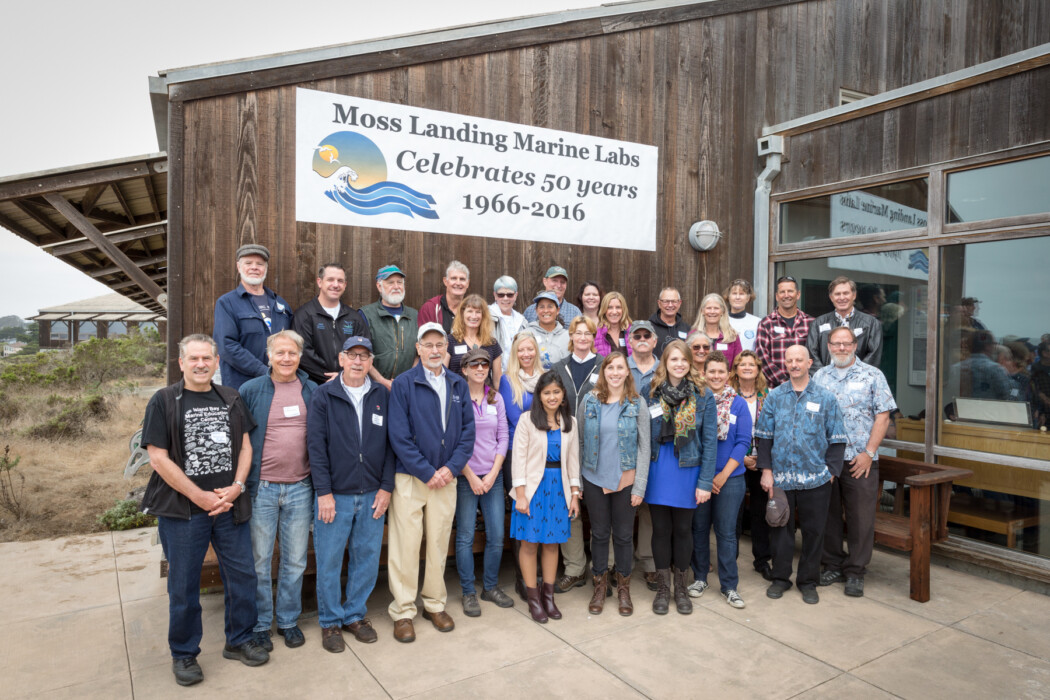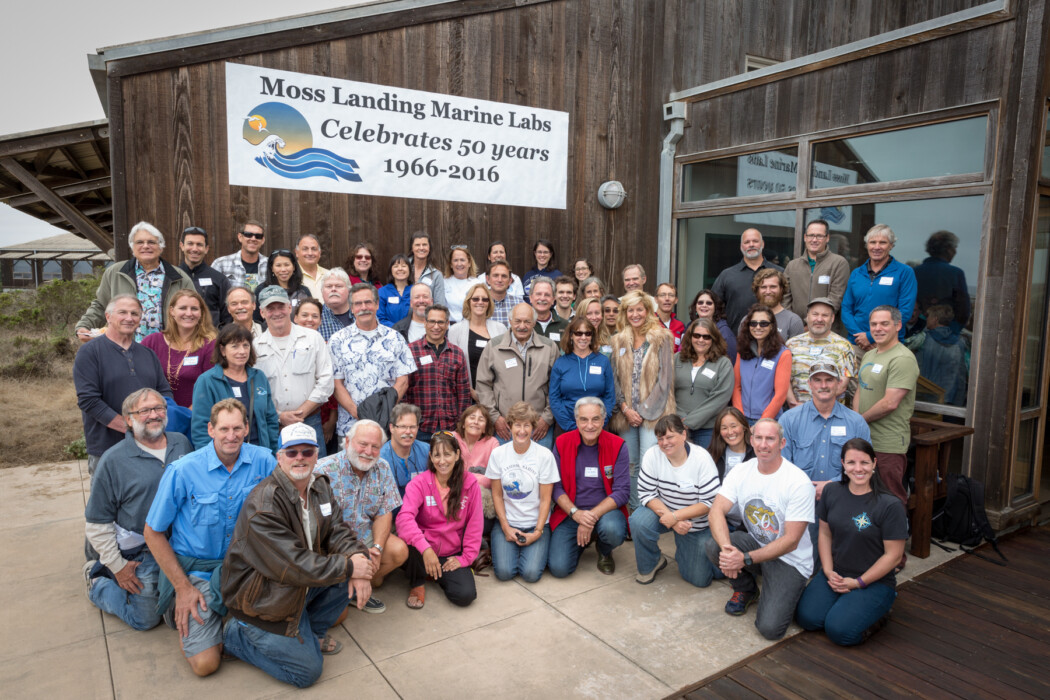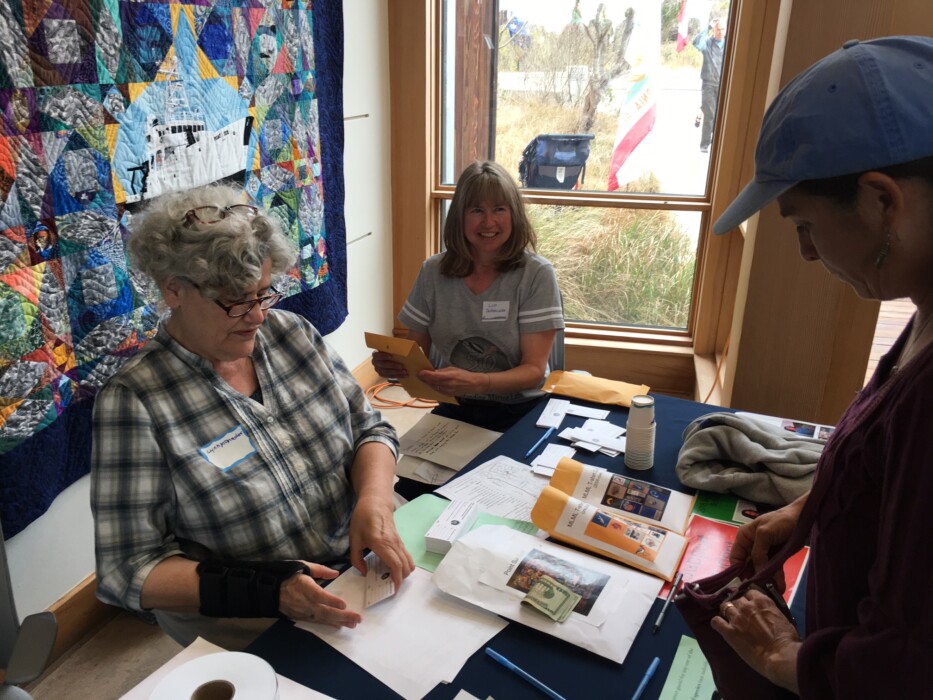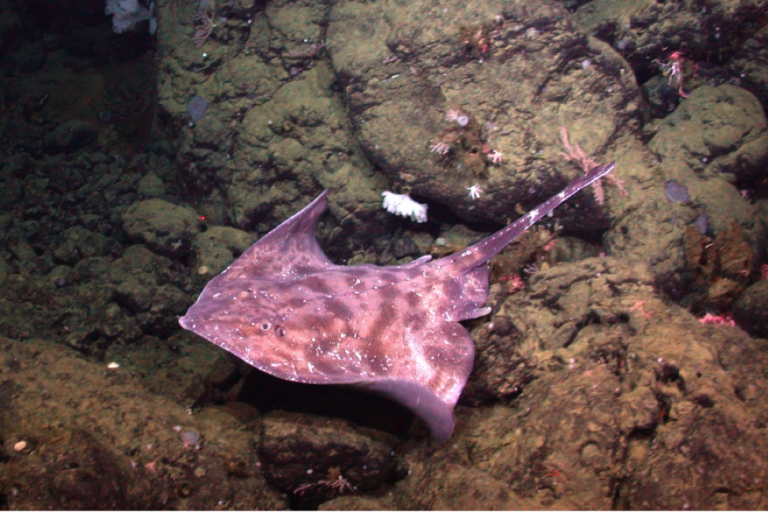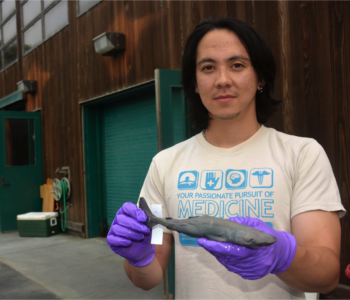By Jim Harvey (15 June 2017)
As I have mentioned before in a previous post, we have secured some funding and procured the services of Nora Deans and Eric Cline to help produce a celebratory and historical book about the first 50 years of MLML.
Here are some mock ups of various aspects of the document so you can get a feel for what we are trying to produce.
Possible Front Cover:
Example of two pages about the Early Years and Open House:
About the MLML Consortium:
We are well along in producing the book but one of the reasons for writing this post is that we need your help. We want to publish the names of all the students that have received their M.S. degrees from MLML, with the year and advisor. But our list is not complete, especially as it relates to the advisor. So can you please take a look at the list below and check your (and others you know) information to see if it is correct, and see if you can provide us needed information in the highlighted areas. Send an email back to us with the correct data. Thanks for your help.
Our current list of MLML M.S. graduates, in alphabetical order. Please check to see if your and others information is correct. Needed data have a question mark and are in red. Email me back with corrections: harvey@mlml.calstate.edu. Gracias.
| Last Name | First Name | MLML Graduation Year | Advisor or Lab |
| Ackerman | Lester | 1971 | Brittan |
| Adams | Joshua | 2004 | Harvey |
| Agegian | Catherine | 1981 | Hurley |
| Ainsley | Shaara | 2009 | Ebert/Cailliet |
| Ajeska | Richard | 1971 | Nybakken |
| Al-Ameri | Lubna | 2007 | Greene |
| Alicea | Antonio Jose | 2001 | Harvey |
| Alifano | Aurora | 2008 | Graham |
| Allen | Jane K. | 1992 | Nybakken |
| Ambrose | David | 1977 | Cailliet |
| Anderlini | Victor | 1972 | Martin? |
| Anderson | Brian | 1987 | Foster |
|
Anderson Anderson |
Todd W. Genevieve (Genny) |
1983 1971 |
Cailliet Nybakken |
| Anderson | Karen L. | 1979 | Cailliet |
| Anderson | M. Eric | 1977 | Cailliet |
| Andrews | Allen Hia | 1997 | Cailliet |
| Annett | Cynthia | 1982 | Nybakken |
| Antonio | Dean F. | 1994 | Foster |
| Antrim | Brooke | 1982 | Cailliet |
| Appiah | James | 1977 | Cailliet |
| Ardizzone | Daniele | 2005 | Cailliet |
| Armstrong | Edward M. | 1996 | Broenkow |
| B. Kauffman | William | 2009 | Coale |
| Baduini | Cheryl L. | 1995 | Harvey |
| Balance | Lisa | 1987 | Wursig? |
| Baltan | Jessica Jill | 2001 | Welschmeyer |
| Baltz | Donald | 1975 | Morejohn |
| Barminski | Robert | 1993 | Broenkow |
| Barnes | Cheryl | 2015 | Harvey |
| Barnett | Lewis | 2008 | Ebert/Cailliet |
| Barry | James | 1982 | Cailliet |
| Battle | Karen E. | 1994 | Nybakken |
| Beatman | Luke | 2006 | McPhee-Shaw |
| Bennett | Tony | 1993 | Cailliet |
| Benson | Scott R. | 2002 | Harvey |
| Benz | Sandy | 1973 | ? |
| Berger | Robert | 1983 | Cailliet |
| Bigman | Jennifer | 2013 | Ebert/Harvey |
| Bitondo | Alicia | 2016 | Geller |
| Bizzaro | Joe | 2005 | Cailliet |
| Black | Nancy A. | 1995 | Harvey |
| Blaskovich | David | 1973 | Broenkow |
| Blueford | Joyce | 1975 | ? |
| Bobco | Nicole | 2014 | Welschmeyer |
| Bockus | Daniel W. | 1999 | Foster |
| Bodensteiner | Laura | 2006 | Coale |
| Booth | Ashely | 2011 | McPhee-Shaw |
| Bork | Ken | 1986 | Ledbetter |
| Boyd | Jenny | 1992 | Harvey |
| Boyer | Shelby | 2010 | Geller |
| Boyle | Mariah | 2010 | Ebert/Cailliet |
| Braby | Caren E. | 1998 | Nybakken |
| Brady | Briana | 2008 | Cailliet |
| Breda | Valerie | 1982 | Foster |
| Breffit | Yvonne | 1976 | ? |
| Brennan | James | 1988 | Cailliet |
| Bretz | Carolyn (Carrie) | 1995 | Oliver/Foster |
| Brewster | Jodi | 2005 | Broenkow |
| Briggs | Kenneth | 1972 | Morejohn |
| Brookens | Tiffini | 2006 | Harvey |
| Brooks | Cassandra | 2008 | Cailliet |
| Brooks | Louise | 2005 | Harvey |
| Broughton | Jennifer | 2010 | Welschmeyer |
| Brower | Jeremiah | 2010 | Aiello |
| Brown | Simon | 2010 | Ebert/Cailliet |
| Brown | Elizabeth A. | 1996 | Harvey |
| Brown | Cynthia | 1990 | ? |
| Browne | Linda | 1997 | Cailliet |
| Browne | Patience | 1995 | Harvey |
| Bryant | Jeff | 1978 | Cailliet |
| Buchanan | Scott | 1990 | Wursig |
| Buckley | Shandy | 2012 | McPhee-Shaw |
| Burd | Matthew A. | 1992 | Harvey |
| Burdett | Kim | 1992 | Foster |
| Burger-Fadely | Janey | 1990 | Harvey |
| Burnett | Nancy | 1972 | Beeman |
| Burrows | Julia | 2009 | Harvey |
| Burton | Erica | 1999 | Cailliet |
| Byington | Amy | 2007 | Coale |
| Byrnes | Pamela E. | 1997 | Harvey |
| Caldwell | Suzanne | 1975 | ? |
| Camilli | Luis | 2007 | Greene |
| Canestro | Don | 1986 | Foster |
| Carle | Ryan | 2014 | Harvey |
| Carlisle | Aaron | 2006 | Cailliet |
| Carr | Mark | 1984 | Cailliet |
| Carroll | Dustin | 2009 | McPhee-Shaw |
| Caskey | Phillip | 1976 | Martin |
| Casson | Kathy | 1980 | Martin |
| Cates | Faye | 1976 | ? |
| Cazenave | Francois | 2008 | McPhee-Shaw |
| Cerchio | Salvatore | 1993 | Harvey |
| Chapin | Thomas | 1990 | Johnson |
| Chapman | John | 1974 | ? |
| Chappell | Paul | 1974 | ? |
| Chartock | Michael | 1969 | Nybakken |
| Cheney | Lisa C. | 1995 | Harvey |
| Chevalier | William J. | 2001 | Welschmeyer |
| Chin | Carol | 1991 | Johnson |
| Chinburg | Susan | 1980 | Arnal |
| Christensen | Robert | 1976 | ? |
| Christian | Vince | 2006 | Foster |
| Cintra-Buenrostro | Carlos | 2000 | Foster |
| Cipriano | Frank | 1983 | Martin |
| Clark | Casey | 2013 | Harvey |
| Clark | Ross P. | 1995 | Foster |
| Clark | Lee R. | 1972 | Broenkow |
| Clark | Patrick | 1972 | Nybakken |
| Clune | William | 1974 | ? |
| Cohen | Joel | 1972 | Moyle |
| Colbert | Debbie L. | 1999 | Johnson |
| Coley | Teresa L. | 1996 | Johnson |
| Collins | Clint | 2015 | Kim/Aiello |
| Connors | Eileen (Sarah ) M. | 2003 | Harvey |
| Conroy | Patrick T. | 1993 | Nybakken |
| Cook | William | 1974 | ? |
| Cooper | John | 1979 | Nybakken |
| Cope | Jason M. | 2002 | Cailliet |
| Cordes | Erik E. | 1999 | Nybakken |
| Cory | Carter | 1976 | ? |
| Courtney | Katherine | 1980 | Ann Hurley |
| Cowen | Robert | 1979 | Cailliet |
| Craig | Susan | 1997 | Nybakken |
| Crane | Nicole L. | 1992 | Harvey |
| Cresswell | Frances | 1985 | Wursig |
| Croll | Donald | 1986 | Wursig |
| Crow | Karen | 1995 | Larson |
| Cruickshank | Marilyn | 2015 | Harvey |
| Culley | Alex I. | 2000 | Welschmeyer |
| Curland | James M. | 1997 | Harvey |
| Curry | Barbara E. | 1990 | Harvey |
| Daly | Brendan J. | 1997 | Cailliet |
| Davis | Chanté | 2006 | Ebert/Cailliet |
| Davis | Paul | 1974 | Foster |
| Davis | William | 1972 | ? |
| Dawson | Cyndi | 2007 | Cailliet |
| de Marignac | Jean | 2000 | Cailliet |
| Dearn | Susan | 1987 | Foster |
| DeBie | Mark S. | 1991 | ? |
| DeVogelare | Andrew | 1986 | Foster |
| Dierks | Ann J. | 1990 | Wursig |
| Dittmer | Eric | 1972 | Arnal |
| Dominik | Clare | 2004 | Foster |
| Donham | Emily | 2016 | Hamilton |
| Donnellan | Michael | 2004 | Foster |
| Donnelly | Erica | 2012 | Harvey |
| Dorfman | Eric J. | 1990 | Harvey |
| Dorrell-Canepa | Joan M. | 1994 | Foster |
| Douglas | Barbara (Tess) | 2013 | Ferry/Cailliet |
| Downing | James W. | 1995 | Foster |
| Drake | Catherine | 2016 | Geller |
| Drake | Michelle | 2013 | Aiello |
| Dreyer | Jennifer | 2011 | Aiello |
| Duryea | Jahnava | 2014 | Cailliet |
| Dykzeul | James | 1976 | ? |
| Eastman | Sally | 1985 | Knauer |
| Eastman | James | 1975 | Nybakken |
| Ebert | Tom | 1988 | Nybakken |
| Ebert | Thomas | 1986 | Nybakken |
| Ebert | David A. | 1984 | Cailliet |
| Eckhardt | Terry | 1975 | Broenkow |
| Edmunds | Jody L. | 2000 | Welschmeyer |
| Edwards | Mathew S. | 1996 | Foster |
| Eguchi | Tomoharu | 1998 | Harvey |
| Eimoto | Dennis | 1976 | ? |
| Eissinger | Richard | 1971 | ? |
| Eliason | Donald | 1985 | Broenkow |
| Elrod | Virginia | 1987 | Johnson |
| Endris | Charles | 2009 | Aiello |
| Engel | Jonna D. | 1997 | Nybakken |
| Erdey | Mercedes | 2007 | Greene |
| Estelle | Veronica B. | 1991 | Harvey |
| Evans | Ronald | 1976 | Lyke |
| Ezcurra | Juan M. | 2001 | Cailliet |
| Fairey | William Russell | 1992 | Johnson |
| Farrens | Gary | 1971 | Silver |
| Farris | Monica | 1977 | Niesen |
| Faurot | Ellen | 1990 | Wursig |
| Feinholtz | Daniela Maldini | 1996 | Harvey |
| Feinholz | Michael E. | 1996 | Broenkow |
| Fellows | Deborah L. | 1980 | Knauer |
| Fennie | Hamilton "Will" | 2015 | Hamilton |
| Ferioli | Laurie J. | 1997 | Johnson |
| Ferry | Lara A. | 1994 | Cailliet |
| Field | Jeff | 2007 | Cailliet |
| Fields | Ryan | 2016 | Hamilton |
| Fields | Doug | 1982 | Cailliet |
| Fisher | Jennifer | 2005 | Kim/Geller |
| Fitzgerald | Laurie | 2003 | Geller |
| Fitzwater | Steve | 1984 | Martin |
| Flammang | Brook | 2005 | Ebert/Cailliet |
| Flegal | Arthur | 1976 | Martin |
| Flora | Stephanie J. | 2001 | Broenkow |
| Forrest | Matthew J. | 2004 | Foster |
| Fox | Michael | 2013 | Graham |
| Frantz | Brian R. | 1999 | Coale |
| Frechette | Danielle | 2010 | Harvey |
| Friend | Theresa | 2003 | Harvey |
| Fry | Jasmine | 2009 | Ebert/Cailliet |
| Fukuyama | Allan | 1985 | Nybakken |
| Fulton-Bennett | Heather | 2016 | Graham |
| Fusaro | Craig | 1969 | Nybakken? |
| Gabara | Scott | 2014 | Graham |
| Gagneron | (Lam) Elizabeth | 2016 | Welschmeyer |
| Gammell | Barry | 1975 | ? |
| Gardner-Taggart | Joan M. | 1991 | Ledbetter |
| Garrick | Huey | 1974 | ? |
| Garrison | David | 1972 | Silver (+ Broenkow) |
| Gashler | Joseph A. | 1996 | Broenkow |
| Gehringer | Daphne | 2007 | Geller |
| Gibble | Corinne | 2011 | Harvey |
| Gibbs | Melissa A. | 1991 | Cailliet |
| Glenn | Kyle | 2009 | Graham |
| Glickstein | Neil | 1977 | Martin |
| Goldberg | Judah | 2003 | Welschmeyer |
| Goldberg | Nisse A. | 2001 | Foster |
| Golson | Emily | 2014 | Harvey |
| Goodyear | Jeff | 1989 | Wursig |
| Gordon | Michael | 1976 | Martin |
| Graham | Tanya | 2009 | Harvey |
| Graham | Michael H. | 1995 | Foster |
| Grannis | Edward | 2006 | Cailliet |
| Grant | Nora | 2009 | Ferry/Graham |
| Grebel | Joanna | 2003 | Cailliet |
| Green | Kristen | 2010 | Cailliet |
| Green | Bonnie | 1978 | Morejohn |
| Greenberg | Nina | 1992 | Nybakken |
| Greene | Nancy | 1982 | Broenkow |
| Greene | Gary | 1970 | Arnal |
| Greenier | Jennifer L. | 1991 | Nybakken |
| Greenley | Ashley | 2009 | Cailliet |
| Greig | Denise J. | 2002 | Harvey |
| Grimm | Brigit | 1989 | Wursig |
| Guenther | Elizabeth A. | 1999 | Johnson |
| Guerrero | Jo | 1989 | Wursig |
| Haas | Diane | 2011 | Ebert/Cailliet |
| Hall | Laurie | 2008 | Harvey |
| Hamilton | Sonia Linnick | 1984 | Nybakken |
| Hanna | Beverly M. | 1991 | Cailliet |
| Hannan (Zimmer) | Cheryl | 1980 | Nybakken |
| Hansen | Judy | 1972 | Silver |
| Hansen | John | 1972 | Tribbey |
| Harvey | Thomas | 1981 | Morejohn |
| Harvey | James Thomas | 1978 | Morejohn |
| Haskins | John C. | 2002 | Coale |
| Hata | Aric | 1976 | ? |
| Hauschildt | Kathy | 1985 | Broenkow |
| Hawes | Sandra | 1983 | Cailliet |
| Hawk | Heather | 2010 | Geller |
| Hawkinson | Craig A. | 1992 | Harvey |
| Head | William | 1974 | Martin |
| Heard | Andrew J. | 1992 | Broenkow |
| Heard | Janet | 1992 | Oberdorfer |
| Heath | Kathryn | 1988 | Mullins |
| Hebel | Dale | 1983 | Knauer |
| Heilprin | Daniel J. | 1992 | Cailliet |
| Heim | Wesley | 2003 | Coale |
| Heimlich-Boran (Boran) | James | 1988 | Wursig |
| Heimlich-Boran (Heimlich) | Sara | 1988 | Wursig |
| Heine | John | 1982 | Foster |
| Helm | Roger | 1979 | Morejohn |
| Henkel | Laird | 2003 | Harvey |
| Hennessy | Scott | 1972 | Morejohn? |
| Herbert | Alan | 1986 | ? |
| Hernandez | Keith | 2016 | Harvey |
| Herrlinger | Tim | 1983 | Nybakken |
| Hester | Michelle | 1997 | Harvey |
| Hilaski | Roger | 1972 | Moyle |
| Hill | Kevin | 1986 | Cailliet |
| Hoelzer | Guy A. | 1982 | Cailliet |
| Holte | Jane E. | 1994 | Foster |
| Honma | Lawrence O. | 1994 | Foster |
| Hoos | Phillip | 2007 | Geller |
| Hooton-Kaufman | Brynn | 2012 | Graham |
| Hoover | Brian | 2013 | Harvey |
| Hornberger | Michelle I. | 1991 | Ledbetter |
| Houk | James | 1970 | Harmon |
| Howard | Alexis | 2014 | Graham |
| Hsieh | Chih-Lin | 1982 | Cailliet |
| Hsueh | Pan Wen | 1989 | Nybakken |
| Huber | Matthew | 2009 | Welschmeyer |
| Hughes | Stephanie | 2012 | Harvey |
| Hughes | Brent | 2007 | Graham |
| Hughes | Bill | 1987 | Shiller |
| Hulberg | Larry | 1978 | Nybakken |
| Hulme | Samuel | 2005 | Greene |
| Hunt | John | 1987 | Nybakken |
| Hunt | Douglas | 1976 | Beeman |
| Hunter | Craig | 1976 | Martin |
| Hunter-Thomson | Kristin | 2011 | Cailliet |
| Hutto | Sara | 2011 | Graham |
| Hymanson | Zachary | 1986 | Foster |
| Iampietro | Pat J. | 1999 | Nybakken/Foster |
| Jacobi | Michele | 1999 | Nybakken |
| Bradford | Donna | 1987 | Cailliet |
| James | Kelsey | 2011 | Ebert/Cailliet |
| James | Dave W. | 1998 | Foster |
| Jefferson | Thomas A. | 1989 | Wursig |
| Jeffries | Sarah | 2015 | Graham |
| Jensen | Erin | 2010 | Geller |
| Johnsen | Jeffrey | 2013 | Welschmeyer |
| Johnson | Shannon | 2003 | Geller |
| Johnson (Schaeffer) | Korie Ann | 1997 | Cailliet |
| Johnson | Eric W. | 1984 | Cailliet |
| Jones | Nathan | 2013 | Harvey |
| Jones | Erin | 2000 | Cailliet |
| Jones | Mary Lou | 1985 | Leadbetter? |
| Jorve | Jennifer | 2008 | Graham |
| Jungmann | Thomas | 1982 | Hassur |
| Kahn | Amanda | 2010 | Geller |
| Kao | Jon S. | 2000 | Cailliet |
| Kaplan | Kristen Brynie | 2000 | Nybakken |
| Karpov | Konstantin | 1977 | Cailliet |
| Kashef | Neosha | 2012 | Cailliet |
| Kashiwada | Jerry | 1981 | Cailliet |
| Kay | Rachel | 2001 | Broenkow |
| Kay | Phillip A. | 1990 | ? |
| Keating | Kelene | 2013 | Welschmeyer |
| Keating | Tom | 1986 | Cailliet |
| Keiper | Carol | 2001 | Harvey |
| Kellogg | Michael | 1982 | Nybakken |
| Kemper | Jenny | 2012 | Ebert/Cailliet |
| Kenner | Michael | 1987 | Foster |
| Kerr | Lisa | 2002 | Cailliet |
| Keusink | Chris | 1979 | Cailliet |
| Kieckhefer | Thomas R. | 1992 | Harvey |
| Kiest | Kim A. | 1993 | Nybakken? |
| Kim | Yong Sung | 1996 | Broenkow |
| Kim | Stacy L. | 1989 | Oliver (Foster) |
| Kimball | Thomas | 2006 | Coale |
| Kimura | Scott | 1976 | Foster |
| King | Chad | 2003 | Geller |
| King | Aaron E. | 1993 | Cailliet |
| King | Jane | 1992 | Nybakken? |
| Kingsley | Eric S. | 1999 | Johnson |
| Kitaguchi | Briar | 2011 | Kim/Aiello |
| Kitazono | Elizabeth T. | 1978 | Broenkow |
| Klaus | Annaliese | 1987 | ? |
| Klaus | Adam | 1986 | Ledbetter |
| Kliever | Richard | 1976 | Cailliet |
| Kline | Donna E. | 1996 | Cailliet |
| Klosinski | Jarred | 2015 | Graham |
| Knesl | Zoe | 2002 | Foster |
| Knowles | Thomas | 2012 | Geller |
| Kohtio | Diana | 2007 | Graham |
| Konar | Brenda J. | 1991 | Foster |
| Krasnow | Lynne | 1978 | Morejohn |
| Kuhnz | Linda | 2000 | Harvey |
| Kukowski | Gary | 1972 | Morejohn |
| Kumar | Anurag | 2003 | Harvey |
| Kuo | Julie | 2015 | Welschmeyer |
| Kusher | David | 1986 | Cailliet |
| Kvitek | Rikk | 1986 | Nybakken |
| Ladizinsky | Nicolas C. | 2003 | Coale |
| Laman | Edward A. | 1998 | Cailliet |
| Lamerdin | Stewart | 2000 | Welschmeyer |
| Lamont | Margaret | 1995 | Harvey |
| Lander | Michelle E. | 1998 | Harvey |
| Landrau | Maria E. | 2000 | Welschmeyer |
| Lasley | Stephen | 1977 | Broenkow |
| Launer | Andrea | 2014 | Harvey |
| Laurent | Laurence | 1971 | Nybakken |
| Lawson | Vera | 2016 | Aiello |
| Leaf | Rob | 2005 | Cailliet |
| Lefebvre | Kathi A. | 1995 | Nybakken |
| Lenihan | Hunter | 1993 | Johnson |
| Leonard | George H. | 1993 | Foster |
| Leopold | William R. | 2000 | Cailliet |
| Leopold | Lawrence | 1972 | ? |
| Levey | Matthew D. | 2005 | Cailliet |
| Levitt | Jennifer L. | 1990 | Niesen |
| Levitt | Jon | 1989 | Arp |
| Lewis | Roger C. | 2002 | Coale |
| Lewis | Lynn M. | 1992 | Nybakken |
| Lewitus | Alan | 1984 | Broenkow |
| Lindquist | David | 1999 | Cailliet |
| Lindquist | David | 1971 | Nybakken |
| Lindsey | Jacqueline (Schwarstein) | 2016 | Harvey |
| Locke | James | 1971 | Arnal |
| Locy | Steven | 1980 | Nybakken |
| Loeb | Valerie | 1972 | Morejohn |
| Lohr | Heather | 2003 | Geller |
| Loiacono | Stephen | 2016 | Geller |
| Lontoh | Deasy | 2014 | Harvey |
| Lopez | Holly | 2007 | Greene |
| Lorne | Michael | 1978 | Martin |
| Loung | Eileen | 1975 | ? |
| Loury | Erin | 2011 | Ebert/Cailliet |
| Lovera | Christopher F. | 2001 | Welschmeyer |
| Lowe | Patricia B. | 1999 | Foster |
| Lundsten | Lonny | 2007 | Geller |
| Mahoney | Melissa | 2002 | Cailliet |
| Manugian | Suzanne | 2013 | Harvey |
| Mariant | Judy J. | 1993 | Ledbetter |
| Marrack | Elizabeth Case | 1997 | Foster |
| Marraffini | Michelle | 2013 | Geller |
| Martin | Linda K. | 1982 | Cailliet |
| Mason | John W. | 1997 | Harvey |
| Matthews | Kathleen | 1983 | Cailliet |
| Maurer | Brian | 2013 | Welschmeyer |
| Mauri | Elena | 2000 | Welschmeyer |
| Mayer | Melanie | 1987 | Foster |
| Mayes | Timothy | 1975 | ? |
| McAfee | Skyli | 1994 | Cailliet |
| McBride | Susan C. | 1990 | Nybakken |
| McConnico | Laurie | 2003 | Foster |
| McCormick | Susan | 1983 | Nybakken |
| McDonald | Gary | 1976 | Nybakken |
| McHuron | Elizabeth | 2012 | Harvey |
| McInnis | Rodney | 1976 | Broenkow |
| McKell | Erinn | 2010 | Welschmeyer |
| McKibbin | Robert | 1975 | ? |
| McMillan | Selena | 2010 | Graham |
| McMillan | Patricia A. | 2003 | Kim/Welschmeyer |
| McNulty | Hilary R. | 1992 | Cailliet |
| Melwani | Aroon | 2004 | Kim/Welschmeyer |
| Mesick | Robert | 1975 | ? |
| Meyer | Robert | 1974 | ? |
| Miller | William | 1975 | ? |
| Mitts | Patrick | 2003 | Greene |
| Moran | Clinton | 2011 | Ferry/Cailliet |
| Moran | Mike | 1976 | Tullis |
| Moreno | Guillermo | 1990 | Cailliet |
| Morrice | Katherine | 2011 | McPhee-Shaw |
| Moser | Doreen | 1996 | Harvey |
| Muhs | Katherine S. | 1998 | Nybakken |
| Muller | Jeff | 1987 | Leadbetter |
| Munroe | Jean | 1969 | ? |
| Murai | Lee | 2007 | Greene |
| Muth | Arley | 2010 | Graham |
| Myers | Allison | 2006 | Coale |
| Nagel | David | 1983 | Mullins |
| Nakagawa | Melinda | 2014 | Harvey |
| Narine | Vidya | 1976 | Baad |
| Natanson | Lisa | 1984 | Cailliet |
| Navas | Gabriela | 2015 | Hamilton |
| Nebenzahl | Debborah A. | 1997 | Cailliet |
| Neer | Julie A. | 1998 | Cailliet |
| Negrey | John | 2013 | Coale |
| Neustrup | Neils | 1976 | ? |
| Nevins | Hannah | 2004 | Harvey |
| Nichols | Stephanie | 2001 | Cailliet |
| Nicholson | Teri E. | 2000 | Harvey |
| Nigg | Eric | 1988 | Foster |
| Nishimoto | Mary M. | 1996 | Cailliet |
| Niven | Eric | 2013 | Aiello |
| Nolten | Jeffery | 1980 | Broenkow |
| Norris | Tenaya | 2013 | Harvey |
| Norris | Thomas F. | 1995 | Harvey |
| Norris | James | 1970 | Bell |
| Novak | Tanya | 2011 | McPhee-Shaw |
| Nowicki | Jocelyn L. | 1992 | Johnson |
| Oakden | James | 1981 | Nybakken |
| Oates | Stori C. | 2005 | Harvey |
| Byrd (Odom) | Barbie | 2001 | Harvey |
| Oeker (Anderson) | Genevieve | 1971 | Nybakken |
| Ohman | Mark | 1976 | Martin |
| O'Kane | John | 1970 | Arnal |
| Okey | Thomas | 1993 | Oliver/Nybakken |
| Oliver | John | 1973 | Nybakken |
| Orr | Anthony J. | 1998 | Harvey |
| Osborn | Steven A. | 1995 | Nybakken |
| Osnes-Erie | Lizabeth D. | 1999 | Harvey |
| Ouellette | Thomas | 1978 | Martin |
| Outram | Dawn | 2000 | Cailliet |
| Overstrom-Coleman | Max | 2009 | Graham |
| Oxman | Dion S. | 1995 | Harvey |
| Pace | Stephen | 1978 | Cailliet |
| Palacios | Sherry L. | 2003 | Foster |
| Palomino | Eufemia | 2002 | Broenkow |
| Parker | Karen | 2013 | Welschmeyer |
| Parker | Pamela | 2006 | Harvey |
| Parkin | Jennifer L. | 1998 | Harvey |
| Peglow | Justin | 2013 | Aiello |
| Perez | Colleena | 2005 | Ebert/Cailliet |
| Perlman | Benjamin | 2010 | Ferry/Cailliet |
| Peters | Darryl W. | 2002 | Broenkow |
| Phillips | Elizabeth M. | 2005 | Harvey |
| Phillips | Bryn M. | 1995 | Nybakken |
| Phillips | Charles | 1978 | Martin |
| Pranger | Mark L. | 1999 | Broenkow |
| Proulx | Steve | 1987 | Cailliet |
| Puglise | Kimberly A. | 2003 | Welschmeyer |
| Purdue | Andrea | 1976 | Martin |
| Quaranta | Kim | 2011 | Ferry/Cailliet |
| Raanan | Ben Yair | 2015 | McPhee-Shaw |
| Ramer | Bernadette | 1985 | Cailliet |
| Rasch | Richard | 1985 | Mullins |
| Rasmussen | Kristin | 2006 | Harvey |
| Raum-Suryan | Kimberly L. | 1995 | Harvey |
| Reaves | Richard | 1983 | Broenkow? |
| Reed | Daniel | 1981 | Foster |
| Reilly | Paul | 1978 | Broenkow |
| Reuter | Rebecca F. | 1999 | Cailliet |
| Reyes | Catalina | 2009 | Graham |
| Reynolds | Kyle | 2009 | Kim/Welschmeyer |
| Rhett | Gillian | 2014 | Harvey |
| Rhodes | Kevin | 1995 | Cailliet |
| Rinewalt | Christopher | 2007 | Ebert/Cailliet |
| Riosmena-Rodriguez | Rafael | 1997 | Foster |
| Roberts | Alice (Atma) | 2001 | Welschmeyer |
| Roberts | Cassandra A. | 1996 | Foster |
| Roberts | Dale | 1979 | Bradbury/Cailliet |
| Robinson | Kristin | 2015 | Geller |
| Robinson | Heather | 2006 | Ebert/Cailliet |
| Romero | Rosemary | 2009 | Graham |
| Rose | Dennis | 1980 | Foster |
| Ross | Bruce E. | 1977 | Arnal |
| Rote | James | 1969 | Martin |
| Ruagh | Amer Ali | 1976 | Cailliet |
| Ruvalcaba | Jasmine | 2014 | Graham |
| San Filippo | Rich A. | 1996 | Cailliet |
| Sanders | Rhea | 2007 | Coale |
| Sandoval | Eric J. | 2005 | Greene |
| Sankaran | Sonya | 2012 | Graham |
| Sassoubre | Lauren | 2008 | Coale |
| Schaadt | Timothy | 2005 | Graham |
| Schaaf | Jayna | 2007 | Ebert/Cailliet |
| Schaeffer | Timothy | 1999 | Foster |
| Schlining | Brian M. | 1999 | Broenkow |
| Schlining | Kyra L. | 1999 | Nybakken |
| Schmeltzer | Emily | 2016 | Hamilton |
| Schmidt | Katherine | 2014 | Cailliet |
| Schneider-Plechner | Barbara S. | 1996 | Foster |
| Schnitzler | Christie | 2005 | Geller |
| Schoenherr | Jill | 1987 | Wursig |
| Scholten | James Walter | 1999 | Harvey |
| Schrader | Carl | 1979 | Foster |
| Schultz | Paul | 1971 | ? |
| Schwartz | David | 1983 | Mullins |
| Scianni | Christopher | 2008 | Welschmeyer |
| Scudder | Barbara | 1984 | Knauer |
| Sekiguchi | Keiko | 1988 | Wursig |
| Shaffer | Jane L. | 1986 | Nybakken |
| Shea | Russell | 1980 | Broenkow |
| Shonman | David | 1976 | Nybakken |
| Shumaker | Evelyn | 1976 | Arnal |
| Silber | Greg | 1986 | Wursig |
| Silberstein | Mark | 1987 | Nybakken |
| Simmons | Keith | 1976 | ? |
| Singer | Michael | 1982 | Cailliet |
| Slattery | Marc Peter | 1986 | Nybakken |
| Slattery | Peter | 1980 | Nybakken? |
| Sliger | Mark | 1982 | Nybakken |
| Smethie | William M. Jr. | 1973 | Broenkow |
| Smith | Sarah | 2009 | Welschmeyer |
| Smith | Wade D. | 2005 | Cailliet |
| Smith | James G. | 2001 | Welschmeyer |
| Smith | Don | 1985 | Martin (and Knauer)? |
| Smith | Richard E. | 1974 | Broenkow |
| Smith-Beasley | Lisa | 1992 | Cailliet |
| Solonsky | Allan | 1983 | Cailliet |
| Sorenson | Fred | 1984 | Nybakken |
| Spalding | Heather L. | 2002 | Foster |
| Spear | Larry | 1987 | Morejohn |
| Stafford | David | 2012 | Cailliet |
| Starbird | Chris | 1993 | Harvey |
| Stein | Janet | 1989 | Wursig |
| Steller | Diana L. | 1993 | Foster |
| Stephenson | Mark | 1974 | Nybakken |
| Stevens | Pat | 1976 | ? |
| Stewart | Katherine | 1976 | Thompson |
| Strauss | William | 1975 | ? |
| Strobel | Burke | 1996 | Foster |
| Strong | Craig | 1990 | Harvey |
| Stuart | Laurie | 1980 | Morejohn |
| Sullivan | Deidre E. | 1994 | Greene |
| Sullivan | Laurie | 1994 | ? |
| Summers | Anne C. | 1993 | Nybakken |
| Suryan | Robert M. | 1995 | Harvey |
| Suskiewicz | Matthew | 2010 | Graham |
| Sweeney | Joelle | 2008 | Harvey |
| Swithenbank | Alan M. | 1991 | Broenkow |
| Szesciorka | Angela | 2015 | Harvey |
| Szoboszlai | Amber | 2007 | Graham |
| Talent | Larry | 1973 | Staebler |
| Tanadjaja | Elsie | 2010 | Aiello |
| Tanner | Melinda | 2016 | Aiello |
| Tarpley | John A. | 1992 | Foster |
| Teas | Howard | 1982 | Broenkow |
| Tershey | Bernie R. | 1993 | Harvey |
| Thomas | Kate | 2008 | Harvey |
| Thompson | Joel | 1983 | Mullins? |
| Thompson | Janet | 1975 | ? |
| Thurber | Andrew | 2005 | Kim/Welschmeyer |
| Tilden | Janet E. | 2005 | Greene |
| Toimil | Lawrence | 1975 | ? |
| Tompkins | Paul | 2011 | Graham |
| Tomson | Janice | 1985 | Ledbetter |
| Toperoff | Amanda K. | 2002 | Harvey |
| Torok | Michael L. | 1994 | Harvey |
| Trejo | Tonatiuh | 2005 | Cailliet |
| Trone | John W. | 1994 | Foster |
| Trumble | Stephen J. | 1995 | Harvey |
| Turnau | Rene | 1987 | Ledbetter |
| Turner | Teresa | 1977 | Nybakken |
| Urrere | Madelain | 1982 | Knauer |
| Uttal | Lisa | 1992 | Nybakken |
| Van Buren | Marik | 1980 | ? |
| Van Dykhuizen | Gilbert | 1983 | Cailliet |
| Van Kelley (Andrews) | Hees | 2014 | Ebert/Hamilton |
| Vanderwilt | Deborah | 1983 | Nybakken |
| Varoujean | Daniel | 1972 | Moyle |
| Vassallo | Marilyn | 1968 | Nybakken |
| Vaughan | Doug | 1978 | Cailliet |
| Vega | Gabriela | 2008 | Kim/Welschmeyer |
| Ventresca | David | 1975 | Morejohn? |
| Vercoutere | Tom | 1982 | ? |
| Versaggi | Charles | 1975 | Morejohn? |
| Volpi | Christina | 2014 | McPhee-Shaw |
| von Langen | Peter | 1996 | Johnson |
| Von Thun | Susan | 2001 | Geller |
| Voss | Tamara | 2002 | Kim/Coale |
| Wade | Pamela Neeb | 2016 | Geller |
| Wadsworth | Thomas | 2009 | Cailliet |
| Wagner | Gala | 2006 | Welschmeyer |
| Wagner | Amy L. | 1994 | Nybakken |
| Waidlich | Russell | 1976 | Broenkow? |
| Wakeham | Bruce | 1974 | ? |
| Walder | Ronald K. | 1999 | Foster |
| Walker | Christine A. | 1998 | Harvey |
| Wallace | Farron | 1986 | Cailliet |
| Walsh | Jonathan | 2011 | Cailliet |
| Waterhouse | Tye Y. | 1992 | Welschmeyer |
| Watson | Daniel | 1976 | Foster |
| Watt | Steven G. | 2003 | Greene |
| Watters | Diana L. | 1993 | Cailliet |
| Watts | Bridget | 2006 | Harvey |
| Webb Wertz | Lisa | 2013 | Harvey |
| Weesner | Michael | 1970 | ? |
| Wehrenberg | Megan | 2009 | Graham |
| Weise | Michael J. | 2000 | Harvey |
| Welden | Bruce A. | 1985 | Cailliet |
| Wheeler | Ashley | 2015 | Aiello |
| White | Michelle D. | 1998 | Nybakken |
| Wieters | Evie A. | 2000 | Foster |
| Wilkin | Sarah M. | 2003 | Harvey |
| Willard | James | 1981 | Lyke |
| Williams | Kristine | 2013 | Harvey |
| Wilson | Carrie Melissa | 2001 | Foster |
| Winton | Megan | 2011 | Ebert/Cailliet |
| Wittlinger | Sara | 2002 | Foster |
| Wold | Lucy | 1991 | Cailliet |
| Wolf | Stephen | 1968 | Arnal |
| Wong | Cary R. | 1989 | Broenkow |
| Woods | April | 2016 | Welschmeyer |
| Woolfolk | Andrea M. | 1999 | Foster |
| Worden | Sara | 2015 | Graham |
| Wright | William | 1979 | Nybakken? |
| Wyatt | Deborah | 1993 | Cailliet |
| Wyse | Diane | 2014 | McPhee-Shaw |
| Yamada | Randy | 1979 | ? |
| Yarbrough | Mark | 1980 | Broenkow |
| Yoklavich | Mary | 1982 | Cailliet |
| Young | Colleen | 2009 | Harvey |
| Yudin | Katherine | 1987 | Cailliet |
| Yuen | Marilyn A. | 1990 | Broenkow |
| Zamzow | Heidi | 1996 | Johnson |
| Zeiner | Sandra J. | 1991 | Cailliet |


